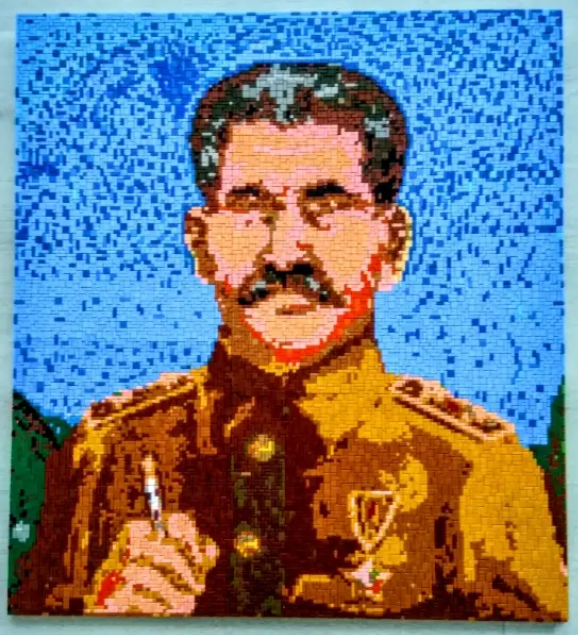Ministeck Stalin
One of the characters that I met on the 386 PC was Stalin, one of the playable leaders in Sid Meier’s Civilization (MicroProse, 1991). Twenty years later, I wanted to personally respond to seeing a genocidal leader as a character in a game. Therefore, I ran a slightly altered version of the DOSBox emulation software on my Linux system, which allowed me to run this old video game and make a screenshot that could be rastered in GIMP image editing software. Armed with this rendering of the image I had remembered, I started to re-create it in Ministeck, which is a LEGO-like toy system for making mosaic pictures (with different colored pieces that have pins on their back, with which they are attached to appropriately perforated plastic plates).

“But why?” you might ask (and indeed this often has been asked). First of all, I really like working with Ministeck—the focus on detail and need for repetitive movements really fit my autism. And the esthetics of the finished products are very similar to the pixelated art of my favorite retro games. But more importantly, I wanted to make an intervention by “changing the stories,” as Haraway has put it. My Ministeck Stalin is a kind of anti-fan art that comments on the representation of Joseph Dzhugashvili in the game Civilization. It is not a parody—it is an observation about how we deal with that piece of history.
As a child, I encountered Stalin in my game as “leader of the Russians”; as an adult, I see young people on the train wearing the hammer and sickle symbol. Similarly, if I were to see Hitler in a child’s play then find myself on the train with passengers sporting swastikas, that would provoke great moral indignation. Stalin is one of the worst war criminals of recent history—the number of people who underwent an unnatural death during his reign is estimated at twenty million, plus another such number to comprise the Russian soldiers and civilians killed by the Germans in World War II. But in Civ, Stalin is depicted like a clownesque cartoon character.
My Civ-Stalin is exemplary and symbolic for the many problems in representations through computer games. Many turn-based single or multiplayer strategy games have colonizing, if not fascist tendencies. They encourage colonial strategies (one game is even called Colonization) and are rather US-centric—for example, in their distribution of the world’s “wonders.” This is a very topical problem and has been noted by other game scholars as well. For example, Dom Ford (2016) demonstrated in his essay in Game Studies that Civilization V is also a very problematic game in terms of (post-)colonial thinking. And Alexander Galloway’s Gaming: Essays on Algorithmic Culture (2006) critiques the whole Civilization series for “its nationalism and imperialism, its expansionist logic, as well as its implicit racism and classism.” Representation is often problematic in cases of historical figures such as Stalin, as well as in the images provided for minority groups.
Also published in Transformative Works and Cultures.